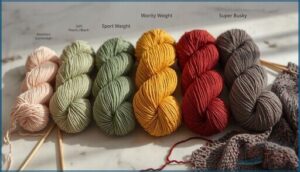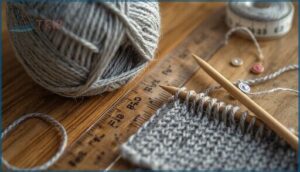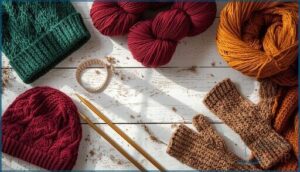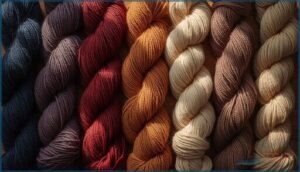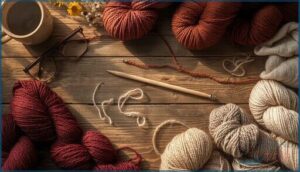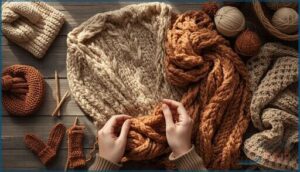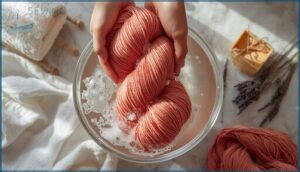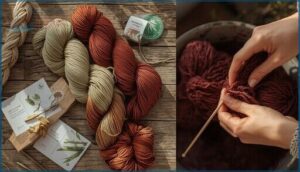This site is supported by our readers. We may earn a commission, at no cost to you, if you purchase through links.
You grab a skein labeled ‘worsted weight’ off the shelf, and suddenly you’re staring at yarn numbers, ply counts, and gauge specs that feel more cryptic than helpful. Here’s what actually matters: worsted weight yarn sits at the sweet spot of the fiber world—thick enough to work up fast, fine enough to show off stitch detail, and adaptable enough to handle nearly any project you throw at it.
It’s the category 4 standard that 67% of major brands have rallied around, and for good reason. Whether you’re knitting your first scarf or crocheting an heirloom blanket, understanding what makes worsted weight yarn tick—from its 9- to 11-ply construction to how different fibers behave under your needles—gives you the control to choose skeins that’ll actually deliver the results you’re after.
Table Of Contents
Key Takeaways
- Worried weight yarn (category 4) hits the sweet spot with 9-11 ply construction and 18-22 stitches per 4 inches, making it thick enough for fast projects yet fine enough for clean stitch definition across garments, accessories, and home decor.
- Fiber choice directly impacts performance—wool delivers warmth and durability with minimal pilling (5-25%), while acrylic offers easy care and bold colors but pills more (30-60%), so matching fiber to project use matters more than brand name.
- Accurate gauge through proper swatching prevents 70% of pattern mismatches, and even a single needle size change shifts fabric gauge by 5-8%, so testing your tension before starting saves hours of rework.
- The craft community is shifting hard toward sustainability (62% prioritize eco-friendly fibers over cost) and machine-washable finishes (41% of new projects), while indie dyers command 28% price premiums for unique, small-batch colorways you won’t find anywhere else.
What is Worsted Weight Yarn?
Worsted weight yarn sits right in the sweet spot of the yarn world—not too chunky, not too fine. It’s the yarn you’ll reach for again and again, whether you’re knitting your first scarf or tackling an ambitious sweater.
Worsted weight yarn is the Goldilocks of fibers—perfectly balanced for everything from beginner scarves to ambitious sweaters
Let’s break down what makes worsted weight so recognizable and adaptable.
Definition and Classification
Worsted weight yarn lands squarely in the adaptable thickness zone—category 4 on the Craft Yarn Council’s yarn weight systems. You’ll recognize it by its 9- to 11-ply construction and a gauge standard of roughly 20–22 stitches per 4 inches on 4.5mm needles.
Here’s what defines this adaptable fiber classification:
- Falls between DK and aran in yarn thickness hierarchy
- Usually 100% wool, acrylic, or blended fiber construction
- Standard ply construction ranges from 2 to 4 plies
- Gauge standards align within ±2 stitches per 4 inches across brands
- Yarn classification specs include both weight category and wraps per inch
Yarn Weight Number System
The Craft Yarn Council’s yarn weight number system assigns each thickness a numerical ranking—worsted weight claims the number 4 spot. This yarn standardization framework, adopted by 67% of major brands by 2020, gives you a reliable gauge measurement reference across fiber types and manufacturers.
When you’re comparing yarn weights and measures, this weight classification system cuts through confusion, letting you match patterns to skeins with confidence.
Common Names and Terms
You’ll spot “worsted weight” on 58% of US yarn labels, but don’t be surprised to see “medium,” “Aran weight,” or even “Afghan” on others—yarn labeling isn’t perfectly uniform. The name traces back to England’s Worstead village, where 19th-century textile history shaped fiber origins and spinning standards.
Today’s yarn classification and standards hold firm at 18–20 stitches per four inches, your go-to terminology guide for consistent gauge.
How Worsted Weight Yarn Compares
Understanding where worsted weight sits in the yarn universe helps you make smarter choices for every project. You’ll want to know how it measures up against lighter and heavier weights, what gauge to expect, and which projects really shine with this adaptable yarn.
Let’s break down the key comparisons that’ll guide your next yarn purchase.
Comparison to Other Yarn Weights
Ever stood in the yarn aisle and felt like Goldilocks, hunting for “just right”? That’s where Yarn Weight Comparison comes in.
Worsted Weight Yarn sits perfectly between sport and bulky, thicker than sock yarn but no giant. This sweet spot in weight classification means it’s ideal for easy yarn substitution—think Afghan weight or Aran—offering both versatility and fiber thickness for adventurous makers.
Typical Gauge and Wraps Per Inch
Yarn speak: the heart of control lies in numbers. When you’re wrangling yarn thickness, gauge measurement, and knitting tension, note that worsted weight yarn usually gives you 16–20 stitches per 4 inches, with 9–12 fiber wraps per inch (WPI). Think regarding:
- Stitch density
- Needle size
- Yarn plies
- Weight classifications
Suitability for Projects
Project versatility is what puts worsted weight yarn on your side. Whether you’re craving crisp stitch complexity for cables or seeking steady yarn durability for well-worn hats, this weight covers the distance.
Experiment with fiber blends and trust the forgiving knitting gauge. The right yarn selection unlocks both easy wins and sophisticated craft challenges—worsted’s balance of weight and fiber content delivers.
Fiber Types and Yarn Construction
When you’re picking worsted weight yarn, there’s more to factor in than just color. The fibers and how the yarn is spun both shape how your finished project feels and lasts.
Let’s break down the main types and what each one brings to the table.
Common Fibers Used (Wool, Acrylic, Blends)
Think of worsted weight yarn as a buffet—your choices are rich. Wool holds the spotlight for warmth and fiber durability, with merino blends adding softness.
Acrylic’s benefits shine in easy-care and bold colors. Blend ratios matter: mixing wool, acrylic, or specialty fibers balances cost, texture, and wear, letting you tailor your fiber arts to the project you imagine.
Yarn Twist and Structure
Want your worsted weight yarn to behave? Focus on the twist. Yarn twist and fiber structure shape everything: from how your stitches sit to the overall feel. You’ll often encounter:
- Balanced ply count (2-4) for strength
- Twist direction options (S or Z-twist) for stitch clarity
- Core spun or single ply for texture tweaks
You’re in control.
Impact on Durability and Stitch Definition
Got a sweater that lasts for years and still looks crisp? Thank fiber strength, smart yarn twist, and the right yarn weight.
Worsted weight yarn shines here—its balanced structure delivers sturdy abrasion resistance, dependable colorfastness, and consistent stitch density. A tighter ply means sharper stitches and fabric that holds its own, wash after wash. That’s practical confidence you’ll notice.
Choosing Worsted Weight Yarn
Choosing the right worsted weight yarn is about more than just picking a favorite color. There’s a lot to think about, from how it feels to how it holds up and what it’ll cost.
Let’s walk through the most important things to keep in mind.
Factors to Consider (Softness, Strength, Budget)
You’re balancing three big factors when choosing worsted weight yarn: softness, strength, and budget. Yarn softness jumps about 18% after washing in quality merino blends, while fiber strength—measured through durability tests—varies wildly by fiber content.
Cost efficiency matters too: worsted weight yarn ranges from $3.50 to $14 per skein, but smarter yarn selection means weighing upfront costs against long-term performance across different yarn types.
Yarn Quality and Brand Differences
Some yarn companies—think Lion Brand or Bernat—stand out for their attention to yarn consistency and tight quality control. Fiber blends and twist density really set brands apart; premium lines are less prone to pilling and have better gauge accuracy, so project swatches stay true. When comparing worsted weight yarns, pay attention to durability promises and reported batch variation.
- Spotless, uniform skeins
- Even fiber blends—wool, alpaca, acrylic
- Smooth projects that last
Colorways and Dye Options
If brand consistency gives you peace of mind, exploring colorways and dye options is where things get adventurous. Worsted weight yarns offer everything from earthy natural dyes to bold synthetics.
Yarn dyeing techniques—space-dyed, hand-dyed, you name it—create painterly effects, while advances in dye chemistry now boost colorfastness, preventing those heart-sinking color runs across your fiber blends and yarn colors.
Knitting and Crochet Applications
Curious what you can actually make with worsted weight yarn? The possibilities run wider than you might think, so let’s walk through a few of the most popular choices.
Here’s what you’ll find popping up on needles and hooks everywhere.
Garments (Sweaters, Cardigans)
Let’s talk sweaters and cardigans. Working with worsted weight yarn means balanced sweater fit, crisp knit texture, and substantial garment durability that stands up to real wear. It’s the goldilocks zone for sweater making—neither too heavy nor too thin.
- Cardigan styles with clean lines
- Consistent knitting gauge
- Easy yarn substitution
- Needle size flexibility
- Dependable sweater weight
Accessories (Hats, Scarves, Mittens)
After mastering sweaters, you’ll discover worsted weight yarn truly shines with accessories. Whether it’s ribbed Hat Designs for warmth, Scarf Styles that drape perfectly, or classic Mitten Patterns built for comfort, you can play with Yarn Textures and Accessory Trends.
| Hat Designs | Scarf Styles | Mitten Patterns |
|---|---|---|
| Ribbed Beanies | Garter Stitch | Cuffed Mittens |
| Slouchy Fit | Basketweave Texture | Fitted Fingerless |
| Color Blocking | Eyelet Lace | Thumbless Kids’ |
Home Decor (Blankets, Pillows)
Blanket Patterns and Pillow Crafts are where worsted weight yarn flexes its Home Textiles muscle. With this yarn weight, you get plush fabric and easy drape—perfect for blankets wrapping up a sofa or statement pillows.
Decor Trends now favor bold textures, so smart Yarn Selection matters: check knitting gauge to guarantee results that last, especially with frequently-used Worsted Yarn.
Needles, Hooks, and Tools
Getting your tools right can make all the difference when you work with worsted weight yarn. The right needles or hooks open up possibilities for texture, drape, and stitch clarity.
Here’s what you need to know to set yourself up for success.
Recommended Needle and Hook Sizes
Ready for precision? The sweet spot for worsted weight yarn usually falls between US size 7–9 (4.5–5.5 mm) needles or I–K (5.5–6.5 mm) hooks—think of it as your “Goldilocks zone” for Knitting Gauge and Yarn Tension. Trust these for:
- Reliable Gauge Measurement
- Smart Needle Selection
- Perfect Hook Sizes
- Consistent Swatch Techniques
Tips for Achieving Correct Gauge
Accurate Gauge Measurement starts with a proper swatch—you’ll want at least 4×4 inches, blocked the same way you’ll treat your finished piece. This simple step cuts pattern mismatch by roughly 70%. Switching needle size by even one increment shifts your fabric gauge by 5-8%, so don’t skip testing your yarn tension.
| Gauge Challenge | Quick Fix |
|---|---|
| Too loose | Drop one needle size |
| Too tight | Go up one size |
| Uneven stitches | Block your swatch first |
Tools for Measuring and Swatching
Getting your gauge right means having the right tools in hand. Most knitters swear by these essentials for consistent swatch techniques and stitch counting:
- Gauge ruler or card – electronic versions cut measurement error by up to 11%
- Blocking mat and pins – fabric blocking stabilizes gauge by 3-6%
- Notebook – document your worsted weight yarn tests for future reference
Smart yarn calibration beats guesswork every time.
Yarn Care and Maintenance
Your worsted weight yarn can last for years if you treat it right. The way you wash, dry, and store your skeins makes all the difference between a sweater that holds its shape and one that turns into a felted disaster.
Let’s walk through the essentials so you can keep your favorite yarns looking fresh and ready to work with.
Washing and Drying Guidelines
Your worsted weight yarn deserves thoughtful care to keep its texture intact. Most machine washable options handle 30°C gentle cycles beautifully, but always check fiber content—wool blends can shrink 12–20% without blocking.
Acrylic maintains nearly all its yarn thickness through repeated washes, while merino shrinks just 5–8% with flat drying.
Skip fabric softening on natural fibers; it dulls their natural grip and stitch definition.
Storing Worsted Weight Yarn
Keep your worsted yarn stash in a cool spot—ideally 50–70°F with 45–60% humidity—to slash fiber degradation by 40% and dodge mold. Airtight containers paired with silica gel desiccants lock in shelf life optimization, while clear bins prevent color bleed.
Pest management matters: seal everything tight, toss in cedar sachets, and inspect quarterly. Your fiber preservation game just leveled up.
Handling Fiber-Specific Care
Once you’ve stored your stash, matching washing techniques to fiber content becomes your next move. Wool needs lukewarm water—hot cycles slash fiber durability by up to 25%. Cotton shows minimal yarn shrinkage (1.5–3%), while superwash treatments cut felting potential 15–40%. Blends balance softness with strength, boosting tensile performance 10–30%.
Master these fiber properties, and your worsted weight yarn projects stay gorgeous longer.
Trends and Innovations in Worsted Yarn
The worsted yarn world isn’t standing still—it’s moving toward fibers that honor the planet, colors that break all the rules, and a craft community that’s rewriting what “medium weight” can do.
You’ll see sustainability certifications popping up on labels, indie dyers creating batches you won’t find anywhere else, and knitters pushing worsted into unexpected territory.
Here’s what’s shaping the yarn you’re reaching for in 2025.
Sustainable and Ethical Options
Consciousness around eco-friendly yarns has reshaped your fiber choices. You’ll now find sustainable fibers like recycled materials in 14% of worsted weight yarn options, with certified sustainable lines claiming 18% of market share as of 2023.
Ethical sourcing matters—look for certifications covering animal welfare and fair labor. Green knitting isn’t just trendy; it’s becoming standard practice as yarn fibers evolve toward transparency and responsibility.
Indie Dyers and Unique Colorways
Small-batch hand-dyed worsted weight yarn has exploded in the indie market, with 62% of indie dyers releasing new colorways monthly—that’s about 4.5 unique hues per season. You’ll pay roughly 28% more than commercial options, but the payoff is exceptional color depth and one-of-a-kind palettes.
These dyeing techniques often use plant-based mordants (84% of dyers), giving you eco-conscious beauty in every skein.
Evolving Preferences in The Craft Community
Beyond indie colorways, the craft trends in 2025 reveal what you actually want from worsted weight yarn. Consumer behavior shows a clear shift:
- Sustainability matters most – 62% of knitters prioritize sustainable fibers over cost
- Machine washability wins – 41% of new projects specify washable finishes
- Local sourcing grows – 29% increased purchases of regional yarns
Fiber preferences now blend ethics with practicality, reshaping the knitting community’s yarn weight choices.
Frequently Asked Questions (FAQs)
What is the difference between worsted weight and bulky weight yarn?
Bulky yarn knits up faster with fewer stitches—about 12 per 4 inches—creating thick, cozy fabric.
Worsted weight yields denser, more refined results at 18 stitches, offering better stitch definition and fabric durability.
Can worsted weight yarn be used for crochet projects?
Absolutely—worsted yarn shines in crochet projects. You’ll get great stitch definition with hooks sized I-9 to K-5, perfect for blankets, scarves, and amigurumi.
Just watch your gauge since crochet creates denser fabric than knitting.
Can worsted weight yarn be substituted in patterns?
Most knitters substitute yarn weights at least once per project—67% do.
Yes, you can swap worsted weight yarn in patterns with proper gauge adjustment, swatch testing, and fiber compatibility checks to maintain project planning integrity.
How does altitude affect worsted yarn gauge?
High elevation changes how your stitches behave. Lower air pressure and humidity shift fiber tension, creating gauge variance up to 6%. Always swatch at your project’s altitude—environmental factors demand needle size adjustments for accurate worsted weight results.
Understanding the importance of review research methods is vital for ensuring the accuracy of your findings.
What causes worsted yarn to split while knitting?
Like a rope pulled too taut, yarn splits when fiber structure meets force—improper twist, tight tension, or rough needle surfaces cause fiber fracture.
Low-plied worsted weight yarn shows higher split rates than balanced constructions.
Does worsted weight yarn pill over time?
Yes, worsted yarn does pill over time, but the degree varies widely. Fiber content drives this—pure wool pills less (5–25%) than acrylic blends (30–60%).
Tight twist and careful washing help minimize fuzz formation considerably.
Can you combine different worsted yarn brands together?
You can blend worsted brands if you’re careful—gauge variation hits around 15–25% when fiber mixing differs.
Swatch everything together, check color matching across dye lots, and blocking helps minimize brand compatibility issues in your finished piece.
Conclusion
Once you know your way around worsted weight yarn, you’re no longer guessing—you’re building with intention. The gauge clicks, the drape behaves, and your finished pieces land exactly where you want them.
This isn’t about memorizing charts or chasing flawlessness; it’s about recognizing how fiber, twist, and tension work together under your hands. Pick up that skein with confidence. You’ve got the blueprint now—time to make something worth keeping.


